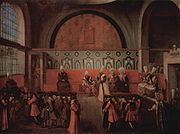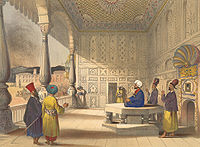
Grand Vizier
Encyclopedia

Turkish language
Turkish is a language spoken as a native language by over 83 million people worldwide, making it the most commonly spoken of the Turkic languages. Its speakers are located predominantly in Turkey and Northern Cyprus with smaller groups in Iraq, Greece, Bulgaria, the Republic of Macedonia, Kosovo,...
Vezir-i Azam or Sadr-ı Azam (Sadrazam) (in Ottoman Turkish
Ottoman Turkish language
The Ottoman Turkish language or Ottoman language is the variety of the Turkish language that was used for administrative and literary purposes in the Ottoman Empire. It borrows extensively from Arabic and Persian, and was written in a variant of the Perso-Arabic script...
: صدر اعظم or وزیر اعظم), deriving from the Arabic
Arabic language
Arabic is a name applied to the descendants of the Classical Arabic language of the 6th century AD, used most prominently in the Quran, the Islamic Holy Book...
word vizier
Vizier
A vizier or in Arabic script ; ; sometimes spelled vazir, vizir, vasir, wazir, vesir, or vezir) is a high-ranking political advisor or minister in a Muslim government....
(وزير), was the greatest minister of the Sultan
Sultan
Sultan is a title with several historical meanings. Originally, it was an Arabic language abstract noun meaning "strength", "authority", "rulership", and "dictatorship", derived from the masdar سلطة , meaning "authority" or "power". Later, it came to be used as the title of certain rulers who...
, with absolute power of attorney
Power of attorney
A power of attorney or letter of attorney is a written authorization to represent or act on another's behalf in private affairs, business, or some other legal matter...
and, in principle, dismissable only by the Sultan himself. He held the imperial seal and could convene all other viziers to attend to affairs of the state; the viziers in conference were called "Kubbealtı viziers" in reference to their meeting place, the Kubbealtı ('under the dome') in Topkapı Palace
Topkapi Palace
The Topkapı Palace is a large palace in Istanbul, Turkey, that was the primary residence of the Ottoman Sultans for approximately 400 years of their 624-year reign....
. His offices were located at the Sublime Porte.
"Grand Vizier" (Vazīr-e Azam) is also the official Urdu
Urdu
Urdu is a register of the Hindustani language that is identified with Muslims in South Asia. It belongs to the Indo-European family. Urdu is the national language and lingua franca of Pakistan. It is also widely spoken in some regions of India, where it is one of the 22 scheduled languages and an...
title of the Pakistan
Pakistan
Pakistan , officially the Islamic Republic of Pakistan is a sovereign state in South Asia. It has a coastline along the Arabian Sea and the Gulf of Oman in the south and is bordered by Afghanistan and Iran in the west, India in the east and China in the far northeast. In the north, Tajikistan...
i Prime Minister (ministers are titled "vizier").
During the nascent phases of the Ottoman state, "Vizier" was the only title used. The first of these Ottoman Viziers who was titled "Grand Vizier" was Çandarlı Kara Halil Hayreddin Pasha
Çandarli Kara Halil Hayreddin Pasha
Çandarlı Kara Halil Hayreddin Pasha was the first vizier of Murad I's reign. He was also the first in Ottoman history who held the title "Grand Vizier", the first who had a military background and the first member of the illustrious Çandarlı Family to hold high office...
. The purpose in instituting the title "Grand Vizier" was to distinguish the holder of the Sultan's seal from other viziers. The initially more frequently used title of vezir-i âzam was gradually replaced by sadrazam, both meaning grand vizier in practice. Throughout Ottoman history, the grand viziers have also been termed sadr-ı âlî ('high vizier'), vekil-i mutlak ('absolute attorney'), sâhib-i devlet ('holder of the state'), serdar-ı ekrem, serdar-ı azam and zât-ı âsafî ('vizieral person').

Köprülü era
The Köprülü era was the period which Ottoman Empire's politics were set by the Grand Viziers, mainly the Köprülü family, which was a notable family of imperial bureaucrats of Albanian origin. Köprülü family generated grand viziers to the Empire, combining ambition with genuine talent...
(1656–1703) the Empire was controlled by a series of powerful grand viziers. The relative ineffectiveness of the sultans and the diffusion of power to lower levels of the government was a feature of the Köprülü Era.
After the Tanzimat
Tanzimat
The Tanzimât , meaning reorganization of the Ottoman Empire, was a period of reformation that began in 1839 and ended with the First Constitutional Era in 1876. The Tanzimât reform era was characterized by various attempts to modernize the Ottoman Empire, to secure its territorial integrity against...
period of the Ottoman Empire
Ottoman Empire
The Ottoman EmpireIt was usually referred to as the "Ottoman Empire", the "Turkish Empire", the "Ottoman Caliphate" or more commonly "Turkey" by its contemporaries...
in the 19th century, the grand viziers came to assume a role more like that of the prime minister
Prime minister
A prime minister is the most senior minister of cabinet in the executive branch of government in a parliamentary system. In many systems, the prime minister selects and may dismiss other members of the cabinet, and allocates posts to members within the government. In most systems, the prime...
s of contemporary Western monarchies.
See also
- List of Ottoman Grand Viziers
- Ottoman EmpireOttoman EmpireThe Ottoman EmpireIt was usually referred to as the "Ottoman Empire", the "Turkish Empire", the "Ottoman Caliphate" or more commonly "Turkey" by its contemporaries...
- VizierVizierA vizier or in Arabic script ; ; sometimes spelled vazir, vizir, vasir, wazir, vesir, or vezir) is a high-ranking political advisor or minister in a Muslim government....

